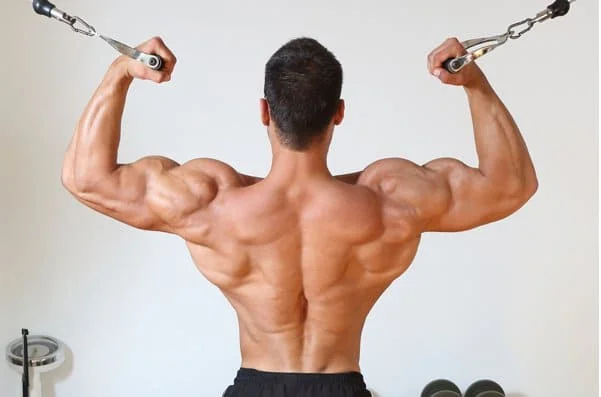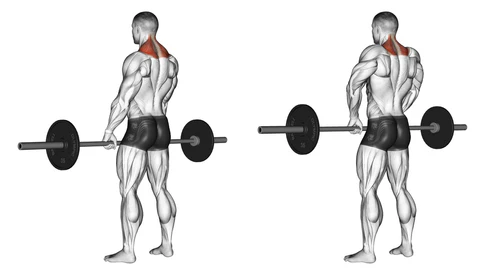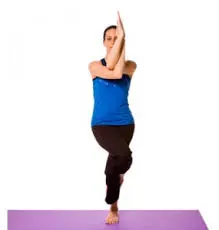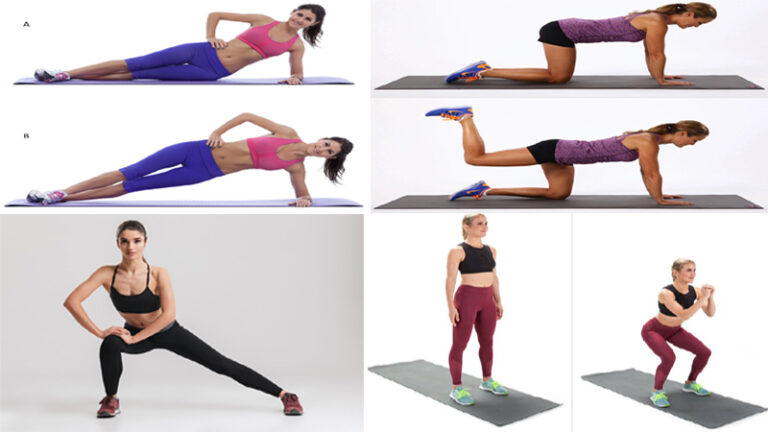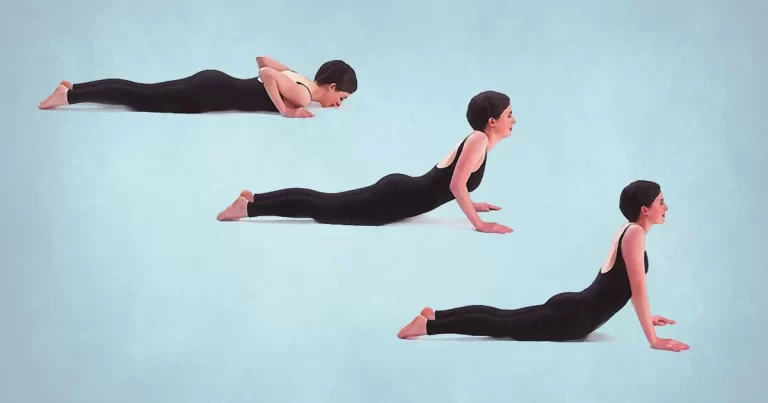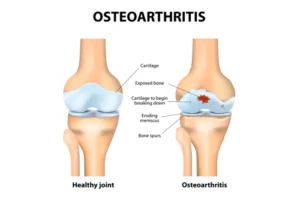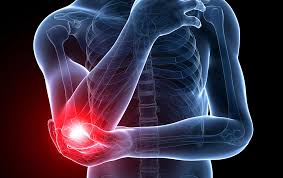Trapezius Exercises for a Stronger, More Muscular Back
Trapezius exercises are essential for building a strong, muscular back and improving your posture. They can also help to prevent injuries and improve your overall athletic performance.
What is the Trapezius Muscle?
The trapezius muscle is a really important muscle in our upper back that helps us move our shoulders and neck. It is a big, triangular-shaped muscle that runs from the base of our skull all the way down to our shoulder blades.
The muscle is divided into three parts, each with its own special job.
- The upper fibers help us raise our shoulders and rotate them outward, which is useful for things like reaching up high or shrugging our shoulders.
- The middle fibers help us pull our shoulder blades closer to our spine, which is important for keeping good posture and staying stable in our upper back.
- The lower fibers help us pull our shoulder blades downward, which can be helpful for lifting heavy objects or pulling on ropes.
Sometimes, we can hurt our trapezius muscle if we use it too much, have bad posture, or get injured. If this happens, we might feel pain, stiffness, weakness, or difficulty moving our shoulder or neck. To fix this, we might need to rest, put ice on the area, do physical therapy exercises, or even have surgery in extreme cases.
Overall, the trapezius muscle is really important for helping us move our upper body and stay strong and stable in our back.
Trapezius muscle exercise
Chin Tuck

Chin Tuck is an exercise that can help stretch and strengthen the trapezius muscle. Here is how to do it:
- Sit or stand with your back should be straight and your shoulders should be relaxed.
- Gently tuck your chin in towards your chest, as if you are trying to make a double chin.
- Maintain this position for 5-10 seconds, then release and relax.
- Do it again the exercise 10-15 times, or as needed.
Lower Trap Lift Off
The lower trap lift-off is an exercise that focuses on the lower trapezius muscle, which is situated in the mid-back area. This exercise helps to strengthen and stabilize the muscles in the shoulder blade region, which can improve posture and reduce the risk of injury.
Here is how to do the lower trap lift-off:
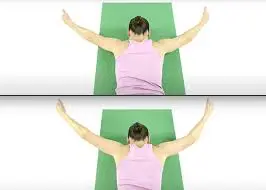
- Start with lying face down on the mat or any flat surface and put your arms by your sides.
- Squeeze your shoulder blades together and raise your arms off the floor, maintaining them straight and parallel to the ground.
- Gradually raise your arms up and away from your body, maintaining your shoulder blades squeezed together.
- Maintain this position for 2-3 seconds, then gradually lower your arms back down to the initiate position.
- Do again this exercise for 10-12 repetitions, focusing on keeping your shoulder blades stable and engaged during the whole movement.
Foam Roller: Thoracic Extension
Foam rolling is a form of self-myofascial release that helps to release tension in the muscles and improve flexibility. The thoracic extension foam roller exercise specifically targets the trapezius muscle, which is located in the upper back and neck area.
Here’s how to do the thoracic extension foam roller exercise:
- Start with lying on your back with a foam roller put horizontally beneath your shoulder blades.
- Cross your arms over your chest or place them behind your head in order to provide support.
- Gradually roll up and down the length of your upper back, focusing on the area between your shoulder blades.
- When you feel a tight spot, pause and hold the position for 10-20 seconds, allowing the foam roller to apply pressure to the muscle.
- Continue rolling up and down for 1-2 minutes, gradually working your way up towards your neck.
Cat-Cow pose (Marjaryasana-Bitilasana)
Cat-Cow pose, also known as Marjaryasana-Bitilasana, is a popular yoga pose that involves moving the spine in a gentle and fluid motion. The pose is often used as a warm-up exercise or as part of a yoga flow sequence. Here is a step-by-step guide on how to perform the Cat-Cow pose:
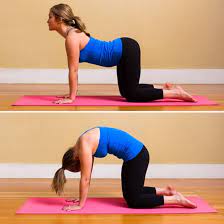
- Begin on your hands and knees with your wrists should be directly beneath your shoulders and your knees should be directly beneath your hips. Make sure your fingers are spread wide and your palms are flat on the ground.
- As you inhale, slowly arch your back and lift your head up towards the ceiling. This is the Cow pose. ensure to keep your shoulders relaxed and at a distance from your ears.
- As you do the exhalation, round your spine and tuck your chin towards your chest. This is the Cat pose. Just as you are pulling your belly button towards your spine.
- Continue to move between the Cow and Cat poses with each inhalation and exhalation. Move slowly and fluidly, allowing your breath to guide the movement.
- Repeat the sequence for several rounds, focusing on the sensation of the movement in your spine.
Neck Rotation
Neck rotation is a simple exercise that can help stretch and strengthen the trapezius muscles in the neck and shoulders. Here is a step-by-step guide on how to perform neck rotation:
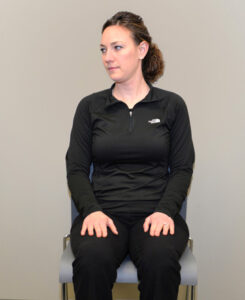
- Sit or stand with your spine must be straight and your shoulders should be relaxed.
- Gradually rotate your head to the right, keeping your chin parallel to the floor. Hold for a few seconds, feeling the stretch in the left side of your neck and shoulder.
- Return your head to the center and then slowly turn your head to the left, keeping your chin parallel to the ground. Hold for a few seconds, feeling the stretch on the right side of your neck and shoulder.
- Repeat this movement for several rounds, moving slowly and smoothly.
- You can also add gentle resistance by placing your hand on the side of your head and gently pressing it as you turn your head. This can help increase the stretch and strengthen the muscles.
Theraband Rows
Theraband rows are an exercise that targets the trapezius muscles in the upper back and shoulders. Here is a step-by-step guide on how to perform Theraband rows:

- Start with sitting on a chair or bench with your feet flat on the floor and your back should be straight.
- Loop a Theraband around a sturdy object, such as a doorknob or post, at chest height.
- Hold one end of the Theraband in each hand, with your palms facing each other and your elbows bent at a 90-degree angle.
- Pull the Theraband towards your chest, squeezing your shoulder blades together and keeping your elbows close to your body.
- Hold for a few seconds, then slowly release the tension and return to the starting position.
- Repeat for several rounds, aiming for 10-15 repetitions per set.
Prone Rows
Prone rows are an exercise that targets the trapezius muscles in the upper back and shoulders. Here is a step-by-step guide on how to perform prone rows:
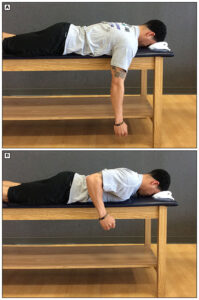
- Lie face down on a mat or bench with your arms extended straight out in front of you and your palms facing down.
- Compress your shoulder blades together, raise your arms off the floor, and keep them straight.
- Bend your elbows and pull your hands towards your chest, squeezing your shoulder blades together even more.
- Hold for a few seconds, then slowly release the tension and lower your arms back down to the starting position.
- Repeat for several rounds, aiming for 10-15 repetitions per set.
Shoulder blade squeeze
The shoulder blade squeeze is a simple exercise that targets the trapezius muscles in the upper back and shoulders. Here is a step-by-step guide on how to perform the shoulder blade squeeze:

- Sit up straight with your feet should be flat on the floor and your hands should be resting on your thighs.
- Roll your shoulders backward and downward, bringing your shoulder blades closer.
- Hold the squeeze for a few seconds, then release and relax your shoulders.
- Repeat for several rounds, aiming for 10-15 repetitions per set.
Shrug
The shrug is another exercise that focuses on the trapezius muscles in the upper back and shoulders. Here is a step-by-step guide on how to perform the shrug:

- Stand with your feet shoulder-width distance and your arms should be at your sides.
- Maintaining your arms straight and raise your shoulders up in the direction of your ears.
- Hold the contraction for a few seconds, then lower your shoulders back down to the starting position.
- Repeat for several rounds, aiming for 10-15 repetitions per set.
Upright row
The upright row is an exercise that focuses on the trapezius muscles in the upper back and shoulders. there is a step-by-step guide on performing the upright row:
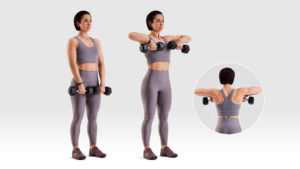
- Stand with your feet shoulder-width apart and hold a barbell or dumbbell in front of your thighs, palms facing down.
- Keeping your elbows close to your body, lift the weights up towards your chin, leading with your elbows.
- Hold the contraction for a few seconds, then lower the weights back down to the starting position.
- Repeat for several rounds, aiming for 10-15 repetitions per set.
Pushup
Pushups are a bodyweight exercise that primarily targets the chest, shoulders, and triceps muscles. However, with slight modifications, pushups can also target the trapezius muscles in the upper back and shoulders. Here is a step-by-step guide on how to perform pushups for trapezius:
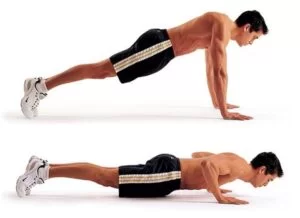
- Begin in a plank position with your hands shoulder-width distance and your feet hip-width distance.
- Lower your body towards the surface bending your elbows, maintaining them closer to your body.
- As you push yourself back up to the starting position, focus on squeezing your shoulder blades together and engaging your trapezius muscles.
- Repeat for several rounds, aiming for 10-15 repetitions per set.
Farmer’s Carry
The Farmer’s Carry is a functional exercise that primarily targets the trapezius muscles in the upper back and shoulders. It is a simple exercise that involves carrying heavy weights in each hand and walking for a set distance or time. Here is a step-by-step guide on how to perform the Farmer’s Carry for trapezius:

- Begin by selecting two heavyweights, such as dumbbells or kettlebells, that you can comfortably carry.
- Stand with your feet hip-width distance and your arms should be at your sides.
- Pick up the weights, one in each hand, and hold them at your sides with your palms facing inward.
- Engage your core muscles and keep your shoulders pulled backward and downward.
- Walk forward, taking small steps and keeping your chest lifted.
- Continue walking for a set distance or time, aiming for 30-60 seconds per set.
- Once you have completed your set, lower the weights back down to the ground and rest for 30-60 seconds before repeating.
Cable Face Pull
The Cable Face Pull is an exercise that targets the trapezius muscles in the upper back and shoulders. It is a great exercise for improving posture, shoulder mobility, and overall upper-body strength. Here is a step-by-step guide on how to perform the Cable Face Pull for trapezius:
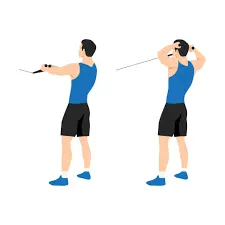
- Begin by setting up a cable machine with a rope attachment at chest level.
- Stand facing the cable machine with your feet shoulder-width distance and your knees should be slightly bent.
- Grasp the rope attachment with both hands, palms facing each other, and step back a few feet to create tension in the cable.
- Engage your core muscles and keep your shoulders pulled backward and downward.
- Pull the rope in the direction of your face, maintaining your elbows higher and wider.
- Squeeze your shoulder blades together at the top of the motion and maintain for a second or two.
- Slowly lower the rope back to the starting position, keeping tension in the cable throughout the movement.
- Do it again for a set number of repetitions or times.
Dumbbell Military Press
The Dumbbell Military Press primarily targets the deltoid muscles of the shoulders, but it also engages the trapezius muscles to a lesser extent. Here’s a simplified explanation of how to perform the Dumbbell Military Press, focusing on the trapezius muscles:
- Start with sitting on a bench with a dumbbell in each hand, palms should be facing forward. maintain your feet flat on the ground and your back should be straight.
- Lift the dumbbells to shoulder level, with your elbows bent and your upper arms parallel to the floor. This is your starting position.
- Exhale and push the dumbbells upward by extending your arms fully. Lift the weights overhead until your arms get fully extended.
- Hold the weights in the fully extended position for a brief moment, focusing on contracting your trapezius muscles.
- Inhale and slowly lower the dumbbells back to the starting position by bending your elbows and bringing the weights down to shoulder level.
- Do the exercise again for several repetitions.
Dumbbell Snatch
The Dumbbell Snatch is a dynamic exercise that primarily targets the muscles of the posterior chain, including the trapezius. Here’s an explanation of how to perform the Dumbbell Snatch, with a focus on engaging the trapezius muscles:
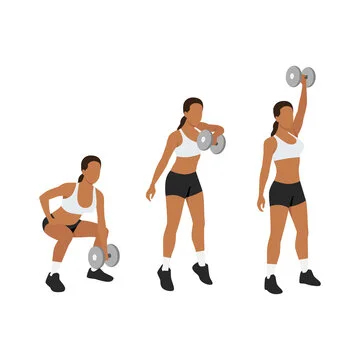
- Start by standing with your feet shoulder-width apart, holding a dumbbell in one hand with an overhand grip. maintain your knees a little bent and your back should be straight.
- Begin the movement by slightly bending your knees and hinging at the hips, lowering the dumbbell towards the ground. Your back should remain straight throughout this phase.
- Explosively extend your hips, driving the dumbbell upwards in a swift motion. As you do this, pull the dumbbell towards your shoulder by bending your elbow and rotating your wrist.
- As the dumbbell reaches shoulder level, quickly drop underneath it by bending your knees and hips, while simultaneously extending your arm overhead. This movement is similar to a partial squat.
- Catch the dumbbell overhead with your arm fully extended, and your palm facing forward. Your trapezius muscles should be engaged to stabilize the weight.
- Reverse the movement by standing up and lowering the dumbbell back down to the starting position in a controlled manner.
- Repeat the exercise for the desired number of repetitions on one side, then switch to the other hand and repeat.
Bent Over Y
The Bent Over Y is an exercise that specifically targets the trapezius muscles, along with other muscles of the upper back and shoulders. Here’s an explanation of how to perform the Bent Over Y exercise:
- Begin by standing with your feet shoulder-width distance and a slight bend in your knees. Hold a pair of dumbbells in your hands, palms facing inward (pronated grip).
- Bend forward at the hips, maintaining your back straight and parallel to the ground. Your torso should be maintained at about a forty-five-degree angle to the floor. Allow your arms to hang straight down from your shoulders, with a slight bend in your elbows.
- Engage your core muscles for stability and keep your neck in a neutral position.
- Begin the movement by simultaneously raising your arms out to the sides and slightly back, forming a “Y” shape with your body. maintain your elbows a little bent during the whole movement.
- Focus on squeezing your shoulder blades together as you lift your arms, feeling the contraction in your trapezius muscles.
- Continue to raise your arms until they are in line with your body, forming a “Y” shape. Your thumbs should be pointing upward.
- Hold the contracted position for a brief moment, focusing on the engagement of your trapezius muscles.
- Slowly lower your arms back to the starting position, maintaining control and feeling the stretch in your trapezius muscles.
- Do again this exercise for several repetitions.
Pull up Shrug
The pull-up shrug is an exercise that primarily targets the trapezius muscles, which are located in the upper back and neck region. This exercise helps to strengthen and develop the trapezius muscles, which play a crucial role in shoulder stability and posture.
Here’s a step-by-step guide on how to perform the pull-up shrug exercise:
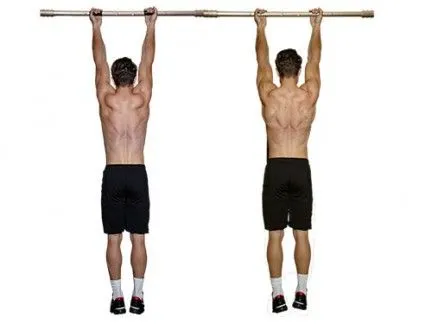
- Begin by standing underneath a pull-up bar with your feet shoulder-width distance. keep the bar with an overhand grip, slightly wider than shoulder-width distance. Your palms must be facing a distance from you.
- Hang from the bar with your arms in full extension and your body should be relaxed. This is the initiate position.
- Engage your core muscles and take back your shoulder blades by pulling them downward and backward. This will help stabilize your shoulders and protect them during the exercise.
- Begin the movement by pulling yourself up towards the bar, using your back muscles. keep focusing on squeezing your shoulder blades together as you raise your body.
- Once you reach the top of the movement, pause for a moment and squeeze your trapezius muscles as hard as you can. This is the shrugging motion that targets the trapezius muscles specifically.
- Gradually lower yourself back downward to the initiate position, keeping control during the whole movement. Fully extend your arms and relax your shoulders before starting the next repetition.
- Repeat the exercise for the desired number of repetitions or as recommended by your fitness program.
The barbell shrug
The barbell shrug is a popular exercise for targeting the trapezius muscles, which are located in the upper back and neck region. This exercise helps to strengthen and develop the trapezius muscles, which play a crucial role in shoulder stability and posture.
Here’s a step-by-step guide on how to perform the barbell shrug exercise:
- Start by standing with your feet shoulder-width apart and place a barbell in front of you on the floor. You can use an Olympic barbell or a barbell specifically designed for shrugs.
- Bend your knees slightly and hinge forward at the hips to grasp the barbell with an overhand grip. Your hands should be a little wider than shoulder-width distance. ensure your palms should be facing your body.
- Engage your core muscles and maintain a straight back during the whole exercise. This will help stabilize your spine and protect it during the movement.
- Begin the movement by lifting the barbell straight up by shrugging your shoulders towards your ears. Focus on squeezing your trapezius muscles as you lift the weight.
- Once you reach the top of the movement, pause for a moment and squeeze your trapezius muscles as hard as you can. This is the peak contraction position that targets the trapezius muscles specifically.
- Gradually lower the barbell back downward to the initiate position, maintaining control during the whole movement. Fully extend your arms and relax your shoulders before starting the next repetition.
- Repeat the exercise for the desired number of repetitions or as recommended by your fitness program.
Rack Pull
The rack pull is an exercise that primarily targets the trapezius muscles, which are located in the upper back and neck region. This exercise helps to strengthen and develop the trapezius muscles, which play a crucial role in shoulder stability and posture.
Here is a step-by-step guide on performing the rack pull exercise:
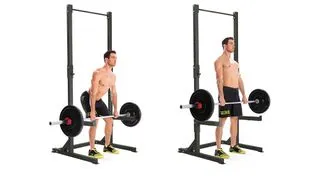
- Start by setting up a barbell on a power rack or squat rack at a height that allows you to comfortably grip the barbell with your arms fully extended. The barbell should be positioned just below knee level.
- Stand in front of the barbell and your feet shoulder-width distance. Position yourself so that the barbell is directly in front of your shins.
- Bend your knees and hinge in the forward direction at the hips to grasp the barbell with an overhand grip. Your hands should be a little wider than shoulder-width distance. ensure your palms should be facing your body.
- Engage your core muscles and maintain a straight back during the whole exercise. This will help stabilize your spine and protect it during the movement.
- Begin the movement by lifting the barbell straight up by extending your hips and knees. Focus on driving through your heels and squeezing your trapezius muscles as you lift the weight.
- Once you reach the top of the movement, pause for a moment and squeeze your trapezius muscles as hard as you can. This is the peak contraction position that targets the trapezius muscles specifically.
- Gradually lower the barbell back downward to the initiate position, maintaining control during the whole movement. Bend your knees and hinge forward at the hips to lower the barbell back to the rack.
- Repeat the exercise for the desired number of repetitions or as recommended by your fitness program.
Dumbbell or Kettlebell Shrug
The dumbbell or kettlebell shrug is an exercise that targets the trapezius muscles, which are located in the upper back and neck region. This exercise helps to strengthen and develop the trapezius muscles, which play a crucial role in shoulder stability and posture.
Here’s a step-by-step guide on how to perform the dumbbell or kettlebell shrug exercise:
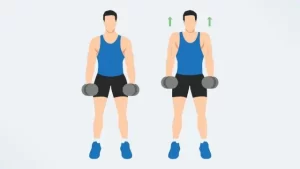
- Start by standing with your feet shoulder-width apart and hold a dumbbell or kettlebell in each hand. keep your arms hanging naturally by your sides, and your palms should be facing your body.
- Engage your core muscles and maintain a straight back during the whole exercise. This will help stabilize your spine and protect it during the movement.
- Begin the movement by lifting your shoulders straight up towards your ears. Focus on squeezing your trapezius muscles as you lift the weights.
- Once you reach the top of the movement, pause for a moment and squeeze your trapezius muscles as hard as you can. This is the peak contraction position that targets the trapezius muscles specifically.
- Gradually decrease your shoulders back down to the initiate position, maintaining control during the whole movement. Relax your shoulders before starting the next repetition.
- Repeat the exercise for the desired number of repetitions or as recommended by your fitness program.
Incline Dumbbell Shrug
The incline dumbbell shrug is an exercise that targets the trapezius muscles, which are located in the upper back and neck region. This exercise helps to strengthen and develop the trapezius muscles, which play a crucial role in shoulder stability and posture.
Here’s a step-by-step guide on how to perform the incline dumbbell shrug exercise:
- Set an incline bench at a 45-degree angle and position it in front of a pair of dumbbells. Choose dumbbells that are appropriate for your fitness level and place them on the floor at the bottom of the bench.
- Sit on the incline bench and your back should be against the bench and your feet flat on the ground. Grasp the dumbbells with an overhand grip, slightly wider than shoulder-width apart. Your palms must be facing toward your body.
- Lean forward slightly and let your arms hang naturally in front of you, with the dumbbells resting on your thighs. This is the starting position.
- Engage your core muscles and maintain a straight back during the whole exercise. This will help stabilize your spine and protect it during the movement.
- Begin the movement by lifting your shoulders straight up towards your ears. Focus on squeezing your trapezius muscles as you lift the weights.
- Once you reach the top of the movement, pause for a moment and squeeze your trapezius muscles as hard as you can. This is the peak contraction position that targets the trapezius muscles specifically.
- Gradually decrease your shoulders back downward to the initiate position, maintaining control during the whole movement. Relax your shoulders before starting the next repetition.
- Repeat the exercise for the desired number of repetitions or as recommended by your fitness program.
Dumbbell Jump Shrug
The dumbbell jump shrug is an explosive exercise that targets the trapezius muscles, which are located in the upper back and neck region. This exercise helps to strengthen and develop the trapezius muscles, while also incorporating power and explosiveness into your training.
Here’s a step-by-step guide on how to perform the dumbbell jump shrug exercise:
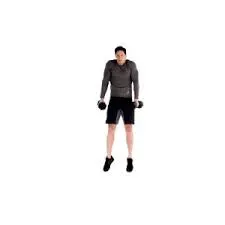
- Begin by standing with your feet shoulder-width distance and holding a dumbbell in each hand. keep your arms hanging naturally by your sides, and your palms should be facing toward your body.
- Engage your core muscles and maintain a slight bend in your knees throughout the exercise. You may develop power and explosiveness by doing this.
- Begin the movement by slightly bending your knees and then explosively extending your hips, knees, and ankles to jump off the ground.
- As you jump, simultaneously shrug your shoulders by lifting them straight up towards your ears. Focus on squeezing your trapezius muscles as you jump.
- Once you reach the peak of your jump, pause for a moment and squeeze your trapezius muscles as hard as you can. This is the peak contraction position that targets the trapezius muscles specifically.
- Land softly on the balls of your feet, absorbing the impact with your legs and knees. Immediately go into the next repetition by transitioning into the next jump.
- Repeat the exercise for the desired number of repetitions or as recommended by your fitness program.
Dumbbell Lateral Raise
The dumbbell lateral raise is an exercise that primarily targets the lateral (middle) head of the deltoid muscles, but it also engages the trapezius muscles to a certain extent. The trapezius muscles assist in stabilizing the shoulders during the movement. This exercise helps to strengthen and develop the shoulder muscles, including the trapezius.
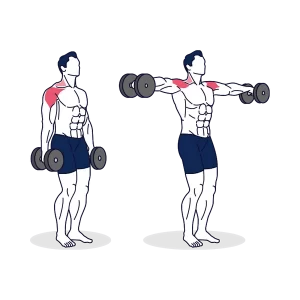
Here’s a step-by-step guide on how to perform the dumbbell lateral raise exercise:
- Begin by standing with your feet shoulder-width distance and holding a dumbbell in each hand. keep your arms hanging naturally by your sides, and your palms should be facing your body.
- Engage your core muscles and maintain a slight bend in your knees throughout the exercise. Your body will become more stable and your lower back will be safeguarded.
- Begin the movement by simultaneously raising both dumbbells out to the sides until your arms are parallel to the floor. maintain a slight bend in your elbows during the whole exercise.
- Targets on leading the motion with your elbows rather than using your hands. This will help engage the lateral head of the deltoid muscles and the trapezius muscles.
- Once your arms are parallel to the floor, pause for a moment and squeeze your trapezius muscles. This is the peak contraction position that targets the trapezius muscles specifically.
- Keep control of the dumbbells the entire time you lower them back to the starting position. Make sure to avoid swinging or using momentum to raise the weights.
- Repeat the exercise for the desired number of repetitions or as recommended by your fitness program.
Overhead Barbell Shrug
The overhead barbell shrug is an exercise that primarily targets the trapezius muscles, which are located in the upper back and neck region. This exercise helps to strengthen and develop the trapezius muscles, which play a crucial role in shoulder stability and posture.
Here’s a step-by-step guide on how to perform the overhead barbell shrug exercise:
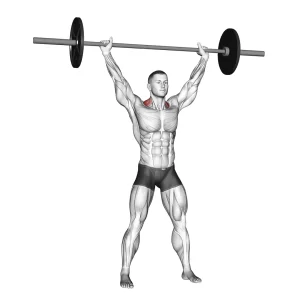
- Start by standing with your feet shoulder-width apart and position a barbell on a squat rack or a power rack at about shoulder height. ensure the barbell is loaded with an appropriate weight according to your fitness level.
- Stand facing the barbell and grip it with an overhand grip, slightly wider than shoulder-width apart. Your palms should be facing forward.
- Lift the barbell off the rack and bring it up to shoulder level, with your arms fully extended. This is your starting position.
- Engage your core muscles and maintain a straight back during the whole exercise. This will help stabilize your spine and protect it during the movement.
- Begin the movement by lifting your shoulders straight up towards your ears, while keeping your arms extended. Focus on squeezing your trapezius muscles as you lift the weight.
- Once you reach the top of the movement, pause for a moment and squeeze your trapezius muscles as hard as you can. This is the peak contraction position that targets the trapezius muscles specifically.
- Gradually decrease your shoulders back downward to the initiate position, maintaining control during the whole movement. Relax your shoulders before starting the next repetition.
- Repeat the exercise for the desired number of repetitions or as recommended by your fitness program.
Snatch-Grip Barbell High Pull
The snatch-grip barbell high pull is an exercise that targets the trapezius muscles, along with several other muscles in the upper body. This exercise helps to strengthen and develop the trapezius muscles, which play a crucial role in shoulder stability and posture.
Here’s a step-by-step guide on how to perform the snatch-grip barbell high-pull exercise:

- Start by standing with your feet shoulder-width apart and position a barbell on the floor in front of you. Use a snatch grip, which means your hands should be wider than shoulder-width apart, with your palms facing down.
- Bend your knees and hinge forward at the hips to grip the barbell with the snatch grip. keep your back straight, and your chest must be lifted.
- Engage your core muscles and maintain a neutral spine during the whole exercise. This will help in stabilizing your body and protecting your back.
- Begin the movement by explosively extending your hips and knees, driving the barbell upward. As you do this, pull the barbell towards your upper chest by shrugging your shoulders and bending your elbows.
- Keep the barbell close to your body as you pull it upward. maintain your elbows higher than your hands at the top of the motion.
- Once you reach the top of the movement, pause for a moment and squeeze your trapezius muscles as hard as you can. This is the peak contraction position that targets the trapezius muscles specifically.
- Lower the barbell back down to the starting position in a controlled manner, reversing the movement pattern. Bend your knees and hinge forward at the hips as you lower the barbell to the floor.
- Repeat the exercise for the desired number of repetitions or as recommended by your fitness program.
Dumbbell Overhead Carry
The dumbbell overhead carry is an exercise that primarily targets the trapezius muscles, along with several other muscles in the upper body. This exercise helps to strengthen and develop the trapezius muscles, which play a crucial role in shoulder stability and posture.
Here’s a step-by-step guide on how to perform the dumbbell overhead carry exercise:
- Begin by selecting a pair of dumbbells that are suitable for your fitness level. Stand tall with your feet shoulder-width distance and keep the dumbbells at shoulder level, palms should be facing forward.
- Engage your core muscles and maintain a neutral spine during the whole exercise. This will help in stabilizing your body and protecting your back.
- Press the dumbbells overhead with the full extension of your hand. Your palms should be facing forward, and the dumbbells should be directly above your shoulders.
- Once the dumbbells are overhead, focus on keeping your shoulders down and back, and your chest lifted. This engages the trapezius muscles.
- Begin walking forward, taking small and controlled steps. maintain your core muscles tight and keep an upright posture.
- As you walk, focus on keeping the dumbbells directly overhead and your shoulders stable. Avoid excessive swaying or inclination to either side.
- Continue walking for a predetermined distance or time, depending on your fitness goals and available space.
- Once you have completed the desired distance or time, lower the dumbbells back to shoulder height in a controlled manner.
Scaption
Scaption is an exercise that primarily targets the trapezius muscle, along with other muscles in the shoulder and upper back region. It involves raising the arms diagonally in a scapular plane, which is a plane that lies between the frontal and sagittal planes of the body.
To perform the scaption exercise for the trapezius, follow these steps:
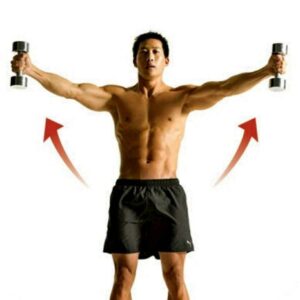
- With your feet shoulder-width apart and your knees slightly bent, stand straight up.
- Hold a pair of dumbbells or any other weighted objects in your hands, with your palms facing inward towards your body.
- Keep your arms straight and relaxed, with a slight bend at the elbows.
- Begin the movement by raising your arms diagonally in front of you, away from your body, while maintaining the same slight bend at the elbows.
- Continue raising your arms until they are parallel to the ground or slightly above shoulder level. Your thumbs should be pointing upwards.
- Hold the raised position for a brief moment, focusing on contracting your trapezius muscles.
- Slowly lower your arms back to the starting position, maintaining control throughout the movement.
- Do the exercise again for the desired number of repetitions.
Trapezius stretch
Shoulder Rolls
The Shoulder Rolls stretch is a simple and effective exercise that targets the trapezius muscle, along with other muscles in the shoulder and upper back region. It helps to improve flexibility, relieve tension, and promote better posture. Here’s how you can perform the Shoulder Rolls stretch:
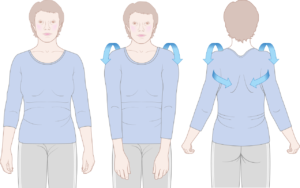
- Stand or sit in a comfortable position and your back should be straight and your shoulders should be relaxed.
- Begin by rolling your shoulders forward in a circular movement. Lift your shoulders up towards your ears, then roll them forward and down in a smooth and controlled manner.
- As you roll your shoulders forward, focus on squeezing your shoulder blades together and feeling a stretch in your trapezius muscles.
- Continue the circular motion for several repetitions, aiming for a smooth and fluid movement.
- After completing the forward rolls, reverse the motion and roll your shoulders backward. Lift your shoulders up towards your ears, then roll them backward and down.
- As you roll your shoulders backward, focus on opening up your chest and feeling a stretch in your trapezius muscles.
- Repeat the backward rolls for several repetitions, maintaining a controlled and fluid movement.
- You can perform the Shoulder Rolls stretch for a desired number of repetitions or for a specific duration, depending on your comfort level and flexibility.
Upper Trap Side Bends
The Upper Trap Side Bends is an exercise that can help stretch and loosen the upper trapezius muscle, which is located in the upper back and neck area. Here’s how to do it:
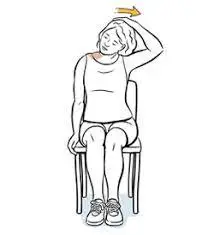
- Start with sit or stand and your back should be straight and your shoulders must be relaxed.
- Lean your head to one side, and take your ear towards your shoulder.
- Use your hand to gently pull your head further towards your shoulder, feeling a stretch on the opposite side of your neck.
- Maintain this position for approximately 15-30 seconds and then release and relax.
- Repeat the exercise on the other side, tilting your head to the opposite side and using your hand to gently pull it further towards your shoulder.
Upper Trap Head Tilts
The Upper Trap Head Tilts stretch is a simple exercise that targets the upper fibers of the trapezius muscle. It helps to improve flexibility, relieve tension, and promote better posture. Here’s how you can perform the Upper Trap Head Tilts stretch:
- Stand or sit in a comfortable position and your back should be straight and your shoulders should be relaxed.
- Begin by tilting your head to the right side, and bringing your right ear towards your right shoulder. You should feel a gentle stretch on the left side of your neck and upper trapezius muscle.
- Hold the stretch for about 15-30 seconds, while maintaining a relaxed and comfortable position.
- Gradually back your head to the center position.
- Repeat the stretch on the opposite side by tilting your head to the left, and bringing your left ear towards your left shoulder. You should feel a gentle stretch on the right side of your neck and upper trapezius muscle.
- Hold the stretch for about 15-30 seconds.
- Return your head to the neutral position.
- You can repeat the Upper Trap Head Tilts stretch for several repetitions on each side, depending on your comfort level and flexibility.
Middle Trapezius Stretch
The Middle Trapezius Stretch is an exercise that targets the middle fibers of the trapezius muscle. It helps to improve flexibility, relieve tension, and promote better posture. Here’s how you can perform the Middle Trapezius Stretch:
- Stand or sit in a comfortable position and your back should be straight and your shoulders should be relaxed.
- Extend your right arm straight out in front of you at shoulder height, with your palm facing down.
- Reach your left arm across your body, placing your left hand on the outside of your right elbow.
- Gently pull your right arm towards your left side, while simultaneously turning your head to the left.
- You should feel a stretch in the middle of your upper back, specifically in the middle fibers of the trapezius muscle.
- Hold the stretch for about 15-30 seconds, while maintaining a relaxed and comfortable position.
- Release the stretch and return your arm and head to the neutral position.
- Repeat the stretch on the opposite side by extending your left arm straight out in front of you at shoulder height, and reaching your right arm across your body to put your right hand on the outer side of your left elbow.
- Gently pull your left arm towards your right side, while turning your head to the right.
- Hold the stretch for about 15-30 seconds.
- Release the stretch and return your arm and head to the neutral position.
- You can repeat the Middle Trapezius Stretch for several repetitions on each side, depending on your comfort level and flexibility.
Sideways Child’s Pose
The Sideways Child’s Pose stretch is a variation of the traditional Child’s Pose that specifically targets the trapezius muscle. It helps to stretch and release tension in the upper back and shoulders. Here’s how you can perform the Sideways Child’s Pose stretch:
- Begin by kneeling on the ground or a mat, and your knees hip-width distance.
- Sit back on your heels and slowly lower your upper body towards the floor, extending your arms forward.
- Walk your hands to the right side, keeping them shoulder-width apart.
- As you walk your hands to the right, simultaneously shift your hips to the left, creating a diagonal stretch through your upper back and trapezius muscle.
- Continue to lower your upper body towards the floor, allowing your forehead to rest on the mat or a prop such as a pillow or block.
- Relax your shoulders and breathe deeply, focusing on releasing any tension in your upper back.
- Hold the stretch for about 30 seconds to 1 minute, or as long as feels comfortable.
- To come out of the stretch, walk your hands back to the center and slowly sit up, returning to a kneeling position.
- Repeat the stretch by walking your hands to the left side and shifting your hips to the right, to stretch the opposite side of your trapezius muscle.
Massage Ball Stretches
Massage ball stretches for the trapezius muscle can be an effective way to release tension and tightness in the upper back and shoulders. Here’s how you can perform massage ball stretches for the trapezius:
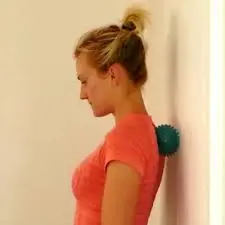
- Start by finding a massage ball, such as a tennis ball or lacrosse ball.
- Stand against a wall or find a sturdy surface to lean against.
- Place the massage ball between your upper back and the wall, targeting the area where your trapezius muscle is located.
- Lean into the ball, applying gentle pressure to the targeted area.
- Begin to move your body up and down, side to side, or in circular motions, allowing the ball to massage the trapezius muscle.
- As you find areas of tension or tightness, pause and apply more pressure to those specific points.
- Continue massaging the trapezius muscle for about 1-2 minutes, or until you feel a release of tension.
- If desired, you can also perform this stretch while lying on the floor, placing the massage ball between your upper back and the floor.
Upper Trapezius Stretches With Ball
Upper trapezius stretches with a ball can be an effective way to target and release tension in the upper trapezius muscle. Here’s how you can perform upper trapezius stretches with a ball:
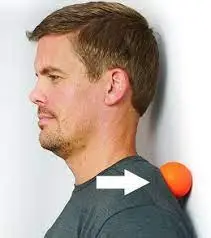
- Start by finding a firm massage ball, such as a tennis ball or lacrosse ball.
- Stand against a wall or find a sturdy surface to lean against.
- Place the ball between your upper trapezius muscle and the wall, targeting the area between your neck and shoulder.
- Lean into the ball, applying gentle pressure to the targeted area.
- Begin to move your head and neck in different directions, such as tilting your head to the side, rotating your head, or nodding your head up and down.
- As you move, allow the ball to roll along the upper trapezius muscle, massaging and stretching the muscle.
- Focus on areas of tension or tightness, pausing, and applying more pressure to those specific points.
- Continue the stretches for about 1-2 minutes, or until you feel a release of tension.
- You can also perform this stretch while sitting in a chair, placing the ball between your upper trapezius muscle and the backrest of the chair.
Middle Trapezius Stretch With Ball
The Middle Trapezius Stretch with a ball is an effective exercise to target and stretch the middle fibers of the trapezius muscle. It helps to improve flexibility, relieve tension, and promote better posture. Here’s how you can perform the Middle Trapezius Stretch with a ball:
- Start by finding a firm massage ball, such as a tennis ball or lacrosse ball.
- Stand against a wall or find a sturdy surface to lean against.
- Place the ball between your middle trapezius muscle and the wall, targeting the area between your shoulder blades.
- Lean into the ball, applying gentle pressure to the targeted area.
- Begin to move your body up and down or side to side, allowing the ball to roll along the middle trapezius muscle.
- As you move, focus on areas of tension or tightness, pausing, and applying more pressure to those specific points.
- Continue the stretches for about 1-2 minutes, or until you feel a release of tension.
- You can also perform this stretch while lying on the floor, placing the ball between your middle trapezius muscle and the floor.
Lower Trapezius Stretch With Ball
The Lower Trapezius Stretch with a ball is an effective exercise to target and stretch the lower fibers of the trapezius muscle. It helps to improve flexibility, relieve tension, and promote better posture. Here’s how you can perform the Lower Trapezius Stretch with a ball:
- Start by finding a firm massage ball, such as a tennis ball or lacrosse ball.
- Lie down on your stomach on a comfortable surface, such as a yoga mat or exercise mat.
- Place the ball under the lower trapezius muscle, which is located between your shoulder blade and spine on the same side.
- Adjust your body position to apply gentle pressure on the ball.
- Begin to move your arm on the same side as the ball, extending it out to the side and overhead, as if you were reaching for something.
- As you move your arm, focus on feeling a stretch in the lower trapezius muscle.
- Hold the stretch for about 15-30 seconds, while maintaining a relaxed and comfortable position.
- Repeat the stretch on the other side by placing the ball under the lower trapezius muscle on the opposite side and extending the arm on that side.
Hug stretch
The Hug stretch is a simple yet effective exercise that targets the muscles in the upper back, including the trapezius muscles. It helps to improve flexibility, relieve tension, and promote better posture. Here’s how you can perform the Hug stretch:
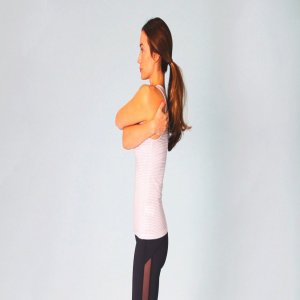
- Stand or sit in a comfortable position and your back should be straight and your shoulders should be relaxed.
- Do the extension of your arms out to the sides, parallel to the ground.
- Cross your right arm over your left arm, bringing your arms together in front of your chest.
- Bend your elbows and bring your forearms perpendicular to the floor, creating a “hugging” position.
- Gently press your forearms against each other, feeling a stretch in your upper back and between your shoulder blades.
- Maintain your shoulders relaxed and do not shrug them up towards your ears.
- Hold the stretch for about 15-30 seconds, while maintaining a relaxed and comfortable position.
- Release the stretch and get back your arms to the initiate position.
- Repeat the stretch by crossing your left arm over your right arm and hugging again.
Crocodile pose (Makarasana)
Crocodile pose, also known as Makarasana, is a yoga pose that can help stretch and release tension in the trapezius muscle. Here’s how to do it:
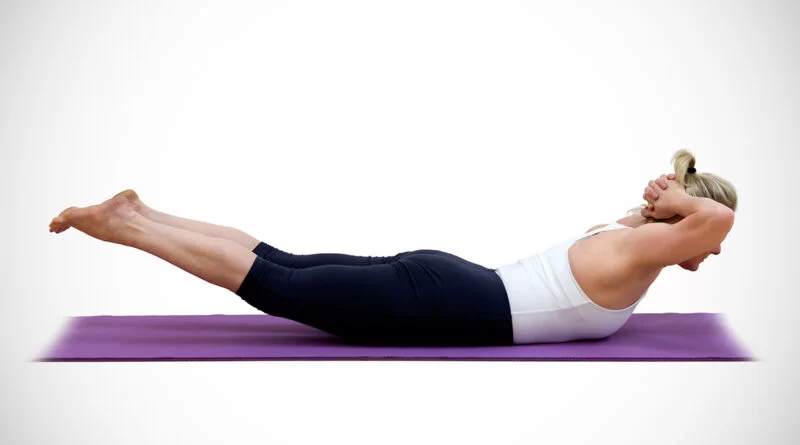
- Lie face down on your stomach with your legs straight and your arms at your sides.
- Bring your hands together and rest your forehead on your hands.
- Take a deep breath in, and as you exhale, gently lift your head, chest, and arms off the ground.
- Maintain your elbows closer to your body and your shoulders should be relaxed as you raise.
- Hold the pose for 10-20 seconds, breathing deeply and relaxing into the stretch.
- Slowly release the pose by lowering your chest, arms, and head back down to the ground.
- Repeat the pose for 2-3 rounds, taking breaks as needed.
Corner Pec Stretch
The Corner Pec Stretch is a popular exercise that can help stretch and relieve tension in the trapezius muscle. Here’s how to do it:

- Find a corner or doorway. Stand facing the corner with your feet shoulder-width distance.
- Place your forearms on each side of the corner, with your elbows at shoulder height.
- Gradually lean forward into the corner until you feel a stretch in your chest and shoulders. ensure to maintain your back straight and your shoulders downward.
- Maintain the stretch for 15-30 seconds, then gradually release and stand up straight.
- Do it again the stretch 2-3 times, or as needed.
Cobra pose (Bhujangasana)
Cobra pose, also known as Bhujangasana, is a yoga posture that primarily targets the muscles of the back, including the trapezius muscles. It is a gentle and effective way to stretch and strengthen the upper body, particularly the shoulders, chest, and spine. Here is a detailed explanation of how to perform the Cobra pose to specifically target the trapezius muscles:

- Start by lying face down on your mat, with your legs extended behind you and the tops of your feet resting on the floor. Place your hands underneath your shoulders, palms down, and elbows tucked close to your body.
- Engage your core muscles by gently drawing your navel in the direction of your spine. Keep your legs active and press the tops of your feet firmly into the ground.
- Inhale deeply and slowly begin to lift your head, chest, and upper abdomen off the mat. make use of the strength of your back muscles to raise, rather than relying only on your arms. Keep your gaze forward, and your neck should be in a neutral position.
- As you continue to lift, straighten your arms and use them for support, but avoid putting too much weight on them. The majority of the effort should come from your back muscles.
- Roll your shoulders back and down, away from your ears, to open up your chest and create space in your neck and upper back.
- Keep breathing deeply as you hold the pose for 15-30 seconds, or longer if comfortable. Focus on relaxing any tension in your neck and shoulders, allowing your trapezius muscles to lengthen and release.
- To release from the pose, exhale and slowly lower your upper body back down to the mat, one vertebra at a time. Rest with your forehead on the mat and take a few deep breaths before moving on to the next posture.
Benafits of the trapazius exercise
The trapezius muscle is a big muscle that extends the upper back, neck, and shoulders. It is responsible for a wide range of movements, including shoulder shrugs, neck extension, and rotation of the shoulder blades. Strengthening and stretching the trapezius muscle can provide several benefits, including:
- Improved posture: The trapezius muscle plays a crucial role in maintaining good posture. Strengthening this muscle can help to keep the shoulders back and down, reducing the risk of hunching or slouching.
- Reduced tension: Tension in the trapezius muscle can lead to pain and discomfort in the upper back and neck. Stretching this muscle can help to release tension and reduce pain.
- Increased range of motion: Strengthening and stretching the trapezius muscle can improve flexibility and range of motion in the shoulders and upper back.
- Injury prevention: A strong and flexible trapezius muscle can help prevent injuries to the shoulders, neck, and upper back. This is especially important for athletes or individuals who engage in activities that place a lot of strain on these areas.
Overall, incorporating exercises that target the trapezius muscle into your workout routine can provide numerous benefits for your overall health and well-being.
Contraindications of trapezius exercise
Contraindications for trapezius muscle exercises refer to situations where performing these exercises may be harmful or detrimental to an individual’s health. Some of the common contraindications of trapezius muscle exercises include:
- Recent injury or surgery: If an individual has recently undergone surgery or suffered an injury to their shoulders, neck, or upper back, they should avoid performing trapezius muscle exercises until they have fully recovered.
- Chronic pain: Individuals who suffer from chronic pain in their shoulders, neck, or upper back should avoid performing trapezius muscle exercises without consulting with a healthcare professional. These exercises may exacerbate the pain and cause further damage to the affected area.
- Osteoporosis: Individuals with osteoporosis, a condition characterized by weak and brittle bones, should avoid performing exercises that involve lifting heavy weights or putting pressure on their spine. Trapezius muscle exercises that require lifting heavy weights may increase the risk of fractures or other injuries.
- Spinal conditions: Individuals with spinal conditions such as herniated discs, spinal stenosis, or scoliosis should avoid performing exercises that involve twisting or bending their spine. Trapezius muscle exercises that require these movements may worsen the condition and cause further damage.
- Cardiovascular conditions: Individuals with cardiovascular conditions such as high blood pressure, heart disease, or arrhythmia should avoid performing exercises that involve lifting heavy weights or performing strenuous activities. Trapezius muscle exercises that require these movements may increase the risk of heart attack or stroke.
FAQ
What is the trapezius muscle?
The trapezius muscle is a large muscle situated in the upper back and neck region. It is responsible for movements such as shrugging the shoulders, rotating the shoulder blades, and extending the neck.
Why should I exercise my trapezius muscle?
Exercising the trapezius muscle can help improve posture, strengthen the upper back and neck, alleviate shoulder and neck pain, and enhance overall upper body strength and stability.
What are some common trapezius exercises?
Common trapezius exercises include shoulder shrugs, upright rows, bent-over lateral raises, face pulls, and seated rows. These exercises target different parts of the trapezius muscle and can be performed with various equipment like dumbbells, barbells, or resistance bands.
How often should I perform trapezius exercises?
The frequency of trapezius exercises depends on your fitness goals and overall workout routine. Generally, it is recommended to train the trapezius muscle 2-3 times per week with at least one day of rest in between sessions.
Can I do trapezius exercises at home without equipment?
Yes, there are several trapezius exercises that can be done at home without any equipment. Examples include bodyweight shrugs, plank shoulder taps, Supermans, and wall angels. These exercises utilize your body weight and focus on engaging the trapezius muscles effectively.
Are there any precautions or modifications for trapezius exercises?
It is essential to maintain proper form during trapezius exercises to avoid injury. begin with lighter weights or resistance and slowly rise as you gain more strength. If you have any pre-existing conditions or injuries, consult with a healthcare professional or a certified trainer before starting any new exercise routine.
How long does it take to see results from trapezius exercises?
The timeline for seeing results can vary depending on factors like consistency, intensity, and individual differences. With regular and proper training, you may start noticing improvements in strength, posture, and muscle definition within a few weeks to a couple of months.
Can trapezius exercises help relieve neck and shoulder tension?
Yes, strengthening the trapezius muscles can help alleviate neck and shoulder tension. The exercises target these areas and can improve muscle endurance, flexibility, and overall posture, which can contribute to reducing tension and discomfort.

